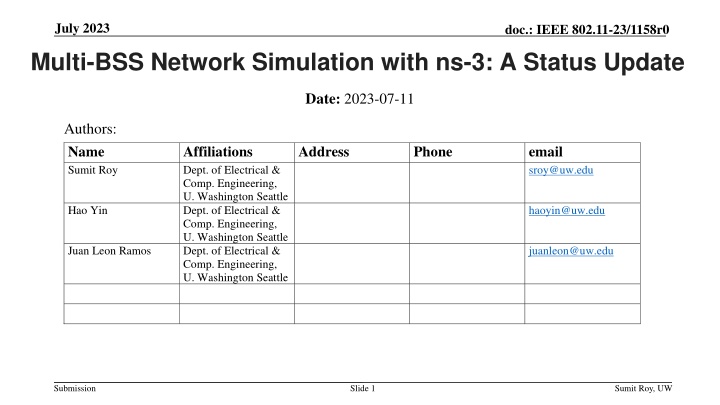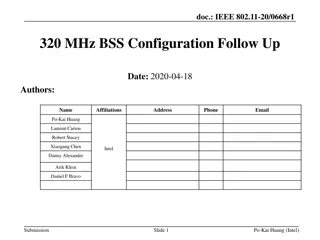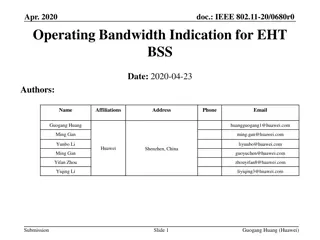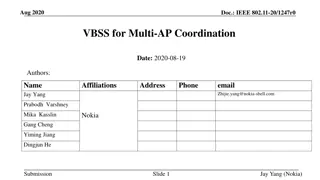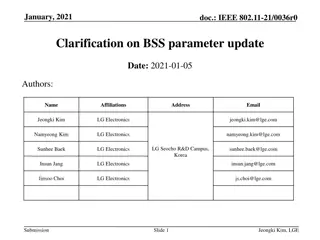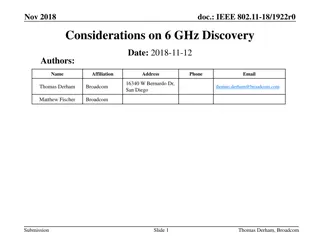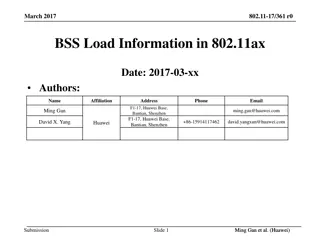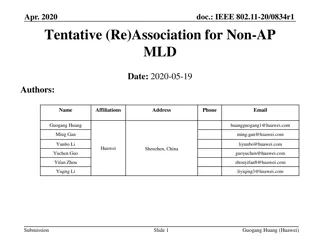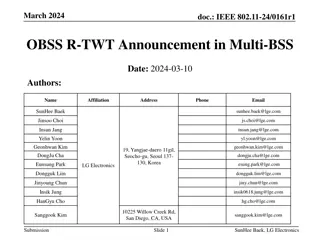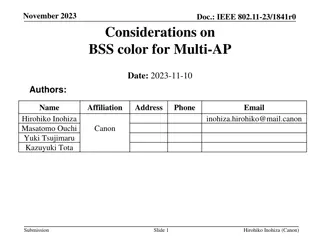Multi-BSS Network Simulation in ns-3 with IEEE 802.11-23 Update
A status update on the WiFi module in ns-3 for IEEE 802.11-23 focusing on advancements like new protocol features, AI/ML integration, and runtime improvements for multi-BSS networks. The simulations cover throughput benchmarks, multi-BSS scenarios, interference parameters, and validation against analytical models. Academic and corporate collaboration enhances ongoing ns-3 development.
Download Presentation

Please find below an Image/Link to download the presentation.
The content on the website is provided AS IS for your information and personal use only. It may not be sold, licensed, or shared on other websites without obtaining consent from the author.If you encounter any issues during the download, it is possible that the publisher has removed the file from their server.
You are allowed to download the files provided on this website for personal or commercial use, subject to the condition that they are used lawfully. All files are the property of their respective owners.
The content on the website is provided AS IS for your information and personal use only. It may not be sold, licensed, or shared on other websites without obtaining consent from the author.
E N D
Presentation Transcript
July 2023 doc.: IEEE 802.11-23/1158r0 Multi-BSS Network Simulation with ns-3: A Status Update Date: 2023-07-11 Authors: Name Sumit Roy Affiliations Dept. of Electrical & Comp. Engineering, U. Washington Seattle Dept. of Electrical & Comp. Engineering, U. Washington Seattle Dept. of Electrical & Comp. Engineering, U. Washington Seattle Address Phone email sroy@uw.edu Hao Yin haoyin@uw.edu Juan Leon Ramos juanleon@uw.edu Submission Slide 1 Sumit Roy, UW
July 2023 doc.: IEEE 802.11-23/1158r0 Abstract An annual update on the status of the WiFi module in the open-source network simulator ns-3 (www.nsnam.org) managed by U. Washington FUNLab (https://wp.ece.uw.edu/funlab/); focus on the advancements made in terms of a) new features added to protocol stack implementations tracking .11ax/.11be as well as enabling use of AI/ML models b) improvements to simulation run-time as a function of multi-BSS network size as well as PHY/MAC cross-layer complexity resulting from focus on HE Acknowledgement: ns-3 WiFi Working Group corporate members - Cisco, Intel, Apple and Max Linear and academic collaborators, whose support contributes to the ongoing enhancements of ns-3 802.11. Submission Slide 2 Sumit Roy, UW
July 2023 doc.: IEEE 802.11-23/1158r0 Throughput : Single-BSS .11ax Benchmark DCF model under saturated traffic, single BSS: Bianchi [1] ns-3 simulations (src/wifi/examples/wifi-bianchi.cc) used to validate simulator against analysis ns-3 Simulation: 5 to 50 nodes, infrastructure network, MCS4 STAs uniformly distributed on a circle; No successful multiple Txmissions! Submission Slide 3 Sumit Roy, UW
July 2023 doc.: IEEE 802.11-23/1158r0 Throughput : Multi-BSS .11ax Axis: AP1 (0, 0) AP2 (d, 0) STAs (0, r) STAs (d, r) 2 Overlapping BSS [2]: Parameters d(inter-BSS distance), r (BSS transmission range) different SINR Variable # STA per BSS, ALL at same location interference AP1 AP2 CCA threshold: -82 dBm, TX power: 20 dBm CCA Range = 30 m CCA Range: 30 meters ??? SINR = MCS PER = 0.01 Log distance path loss (PL) model (????+?????) 4.58 dB 0 ???= ??? ?? ? ????= ??? ??( ?2+ ?2) Uplink traffic only 10.53 dB 2 17.31 dB 4 23.35 dB 6 29.24 dB 8 SINR required for target PER, packet size 1500 bytes Submission Slide 4 Sumit Roy, UW
July 2023 doc.: IEEE 802.11-23/1158r0 Throughput Multi-BSS .11ax Case 1: Two BSS T put equiv. one large BSS Setup: Total 50 STAs (25 STAs in each BSS) r = 8m, d = 5m, ?2+ ?2 = 9.5m, SINR = 2 dB SINR = 2 dB No successful simult. transmissions for ALL MCS ALL nodes within a carrier sensing range of 30 m (i.e., can sense each other) 2 BSS ~ One larger cell Results: Parameters Value -61.6 dBm -64.6 dBm Noise -128 dBm SINR 2 dB ??? ??? Results validated against Bianchi model predictions Example Codes: https://gitlab.com/haoyinyh/ns-3-dev/-/tree/multibss Submission Slide 5 Sumit Roy, UW
July 2023 doc.: IEEE 802.11-23/1158r0 Throughput Multi-BSS .11ax Case 2: Successful Simultaneous transmission @ low MCSs Setup: Total 50 STAs (25 STAs in each BSS) r = 10m, d = 20m, r2+ d2 = 22.3m, SINR = 12 dB SINR = 12 dB Can support successful simult. transmission at MCS 0/1/2 ALL nodes within a carrier sensing range of 30 m (i.e., can sense each other) Expectation: 2 BSS has larger throughput in MCS 0/1/2 than one large cell Results: ??? -65 dBm ??? -77.2 dBm Noise -128 dBm SINR 12 dB Successful simultaneous transmission happens when MCS < 3 multi-BSS throughput is larger when MCS < 3 Large single BSS throughput validated against the Bianchi model (similar to Case 1) Parameters Value Submission Slide 6 Sumit Roy, UW
July 2023 doc.: IEEE 802.11-23/1158r0 Throughput Multi-BSS .11ax Case 3: Successful Simultaneous transmission @ all MCSs Setup: Total 50 STAs (25 STAs in each BSS) r = 3m, d = 20m, ?2+ ?2 = 20.3m, SINR = 28.9 dB SINR = 28.9 dB Can support successful simult. transmission at all MCSs ALL nodes within a carrier sensing range of 30 m (i.e., can sense each other) Expectation: 2 BSS has larger throughput for all MCSs than one large cell Results: Parameters Value -46.7 dBm Successful simultaneous transmission happens for all MCSs multi-BSS throughput is UNIFORMLY larger Large single BSS throughput validated against the Bianchi model (similar to Case 1) ??? -75 dBm ??? Noise -128 dBm SINR 28.9 dB Can we adjust universal CCA threshold over all BSSs to gain FURTHER from successful simultaneous transmission? Submission Slide 7 Sumit Roy, UW
July 2023 doc.: IEEE 802.11-23/1158r0 Changing CCA-PD: Simple 2-BSS case CCA -79 dBm, range 25m r d r STA2 AP 2 STA1 AP1 CCA -76 dBm, range 20m CCA -82 dBm, range 30m r = 5 m, d=20 m, ??? = 20 dBm At STA1 Log distance propagation model ???1(???2) = ???(???2) ??(?+d+r) = -82 dBm ?? ??? = ?0+ 10 ? log10(??? n: the path loss distance exponent, n=3.5 ?0: reference distance, ?0= 1 ? ?0: path loss at reference distance (dB), ?0 = 50 ?0) ???1(??2) = ???(??2) ??(?+d) = -79 dBm At AP1 ???1(???2) = ???(???2) ??(?+d) = -79 dBm ???1(??2) = ???(??2) ??(d) = -76 dBm ???(???1) (??? (???2)+?????) = 24 dB ???(???1) (??? (??2)+?????) = 21 dB Interference from STA2 at AP1: SINR(AP1) = Interference from AP2 at AP1: SINR(AP1) = Submission Slide 8 Sumit Roy, UW
July 2023 doc.: IEEE 802.11-23/1158r0 Changing CCA-PD: Simple 2- BSS case r d r STA2 AP 2 STA1 AP1 ???1(???2) =-79 ??? ???1(??2) =-76 ??? ???1???2 = 82 ??? ???1??2 = 79??? Packet error rate for different MCSs and SINR Change CCA thresholds: MCS ??(?? ??) ??(?? ??) (CCA <= -82 dBm) Case1: 2-BSS all within the CCA range 0-4 0 0 (-82<CCA<= -79 dBm) Case2: 2-BSS, STA1 can t hear STA2 5 0 0.27 (-79<CCA<= -76 dBm) Case3: 2-BSS, STA1 can t hear Network2 6 0.001 0.99 (CCA > -76 dBm) 7 0.05 1 Case4: 2-BSS, Network 1 and 2 can t hear each other 8 1 1 ???(???1) (??? (???2)+?????) = 24 dB: STA1 collides with STA2 at AP1 ???(???1) (??? (??2)+?????) = 21 dB: STA1 collides with AP2 (ACK) at AP1 SINR(AP1) = SINR(AP1) = Submission Slide 9 Sumit Roy, UW
July 2023 doc.: IEEE 802.11-23/1158r0 Throughput Simulation Results Traffic: UL Only, 2 Nodes (one AP ,one STA) in each network MCS ??(?? ??) ??(?? ??) 0-4 0 0 Packet error rate for different MCSs and SINR 5 0 0.27 6 0.001 0.99 7 0.05 1 8 1 1 MCS Single BSS CCA <= -82 CCA > -76 2*Single BSS STA1 and STA2 can have two successful simultaneous transmission at MCS 0-4 As CCA threshold increases throughput increases After the CCA > -76 dBm: two networks can t hear each other, and aggregate throughput is doubled compared with single BSS 2 19.3 20.7 38.7 38.6 3 25.3 27.2 50.6 50.6 4 36.4 39.4 72.8 72.8 Submission Slide 10 Sumit Roy, UW
July 2023 doc.: IEEE 802.11-23/1158r0 Throughput Simulation Results Traffic: UL Only, 2 Nodes (one AP ,one STA) in each network MCS ??(?? ??) ??(?? ??) 0-4 0 0 Packet error rate for different MCSs and SINR 5 0 0.27 7 0.05 1 8 1 1 MCS Single BSS CCA <= -82 CCA > -76 2*Single BSS STA1 and STA2 will see errors when two network have simultaneous transmission For MCS 5-7, error rate is low when two STAs transmit, throughput increases as CCA increases but < 2x single network t put For MCS8, two STAs can t have any simultaneous transmission. As CCA increases, hidden terminals occur and leads to large throughput drop! 5 46.3 50.4 91.9 92.6 7 51.4 61.2 88.9 102.8 8 56.1 63.0 50.7 112.2 Submission Slide 11 Sumit Roy, UW
July 2023 doc.: IEEE 802.11-23/1158r0 More complex cases: nSTA > 2 More stations (nSTA = 10), distributed on a circle, r = 5m, d = 20m, ?_?? = 20 dBm: Different interference level: -82 dBm < ???1 < -69 dBm Optimization of CCA: trade-off between hidden and exposed terminals As MCS increases, optimal throughput achieved @ lower CCA threshold since it requires a higher SINR for success CCA -79 dBm, range 25m CCA -76 dBm, range 20m r r d AP2 AP1 CCA -82 dBm, range 30m Analysis in [4] to find the optimal CCA threshold for a homogeneous network with constant link distances. See analysis in [3] for optimal CCA threshold for a homogeneous network with constant link distances. Submission Slide 12 Sumit Roy, UW
July 2023 doc.: IEEE 802.11-23/1158r0 ns-3 Rx Decoding Summary (1) 1. Single node transmission: No Drop Multiple STAs/BSSs and everyone can hear each other Synchronous Collision During Preamble: Collisions due to same backoff window count. Drop occurs in the first 4 us of HE preamble 2. 36 us HE Preamble Data HE Preamble Data Submission Slide 13 Sumit Roy, UW
July 2023 doc.: IEEE 802.11-23/1158r0 ns-3 Rx Decoding Summary (2) 3. Multiple BSSs and not everyone can hear each other Asynchronous Collisions During HE Preamble: Collisions due to nodes outside of CCA range. Collision occurs after first 4 us of the signal reception and before the end of HE preamble (36 us) HE Preamble Data HE Preamble Data Asynchronous Collisions During Payload: Collisions due to nodes outside of CCA range. Collision occurs after HE preamble (36 us). CRC fail HE Preamble Data HE Preamble Data Submission Slide 14 Sumit Roy, UW
July 2023 doc.: IEEE 802.11-23/1158r0 ns-3 Labels: PHY Reception Failure Cases Results: For 2 BSSs, the failure/success probability vs PD threshold nSTA=10 Per BSS AMPDU disabled r = 5 m, d=20 m, ??? = 20 dBm, same log distance pathloss model For MCS = 4 Percentage: Failed Simultaneous Tx over Total Simultaneous Tx Data Collision During HE Preamble (% over Total Simult Tx) Data Collision During Payload (% over Total Simult Tx) Failed Simult Tx (% over Total Simult Tx) Intra-BSS Success (% over Total Simult Tx) Inter-BSS Success (% over Total Simult Tx) Aggregated Throughput (Mbps) CCA (dBm) CCA Range (m) Total Simult Tx (% over Total Tx) Total Tx -82 30 16783 (69.81%) 0 7256 (30.18%) 84529 24039 (28%) 16743 (69.65%) 0 28.11 -78 24 84775 24474 (28%) 16604 (67.84%) 0 7870 (32.15%) 16267 (66.46%) 307 (1.25%) 28.35 -74 18 119333 65261 (54%) 23224 (35.58%) 0 42035 (64.41%) 19095 (29.25%) 4100 (6.28%) 40.27 -70 14 91541 31943 (34%) 9609 (30.08%) 0 22334 (69.91%) 7876 (24.64%) 1707 (5.34%) 27.73 -66 11 90704 29019 (31%) 6514 (22.44%) 0 22505 (77.55%) 6049 (20.82%) 446 (1.53%) 26.06 -62 8 96185 41874 (43%) 19790 (47.26%) 31 (0.07%) 22053 (52.66%) 10244 (24.44%) 9231 (22.04%) 20.84 Submission Slide 15 Sumit Roy, UW *in this table - small amount of PHY reception failure such as "TXING happen due to beacon + data collisions not accounted for
July 2023 doc.: IEEE 802.11-23/1158r0 802.11ax TGax Residential Scenario [4] Each apartment - square with dim. X m. by X m. All STAs associate with AP in its own apartment/cell AP and STAs are randomly distributed in the square TGax defined pathloss for this scenario: Consider mixed traffic types VR/AR burst traffic: ns-3 VR traffic model [5] CBR traffic as background Distance to AP MCS Distance to AP MCS < 11 m 11 27 m 6 12 m 10 29 m 5 Auto MCS Allocation: For each STA, fix MCS based on the distance to the AP Choose the MCS that achieves less than 1% PER 13 m 9 31 m 4 18 m 8 42 m 3 26 m 7 52 m 2 Submission Slide 16 Sumit Roy, UW
July 2023 doc.: IEEE 802.11-23/1158r0 VR/AR Gaming Scenario 15 m VR/AR delay and throughput requirements [6] Parameters for other nodes [7] Use Cases E2E Delay Requirement Bandwidth Simulation Setup Default value 15 m Parameters UL traffic Traffic type <5ms@50% <10ms@95% <100ms@99.99% VR/AR BSS1 BSS2 ~50Mbps@4K Real-time Video Streaming CBR1.5 Mbps Traffic Rate Packet size 1500 Byte per MPDU Example Setup 4 BSSs co-channel (80 MHz) AP and STA randomly distributed in 15m x 15m square (each apartment) AP & STA TX Power: 12 dBm TGax indoor pathloss model One VR Node in BSS-1: VR Traffic Rate: 50Mbps, 62000 bytes, interval 10 ms [8] Background Traffic: Per-Node UL CBR 1.5 Mbps Total Number of STAs per BSS: 4, Auto MCS change CCA PD on BSS1, CCA on other BSSs is constant: -82 dBm Simulation duration: 100 s BSS4 BSS3 TGax Residential Scenario Can we adjust CCA PD in BSS1 to Fulfill the latency constraint & data rate for VR Maximize aggregate throughput of network Submission Slide 17 Sumit Roy, UW
July 2023 doc.: IEEE 802.11-23/1158r0 Simulation Results Different realizations: Nodes are randomly distributed within a room with different (x, y); 100 cases Brute force search for CCA-PD value in BSS-1 (VR) plot CDF for all 100 realizations as a function of CCA-PD 51 Mbps 5 ms 10 ms 100 ms Table: Results over different CCA PD (dBm) for R1 and R2 Due to topology changes and effect of the walls noticeable variances for the 100 realizations By choosing a constant CCA-PD regardless of locations in different realizations: can not meet VR requirements always (only around 80% cases met all the requirements). Different network topologies, have different optimal CCA PD thresholds! (As shown in the table for 2 example scenarios) Results Realization -82 dBm R1 R2 R1 R2 R1 R2 R1 R2 R1 R2 -78 dBm 51.82 51.82 3.80 3.91 9.25 6.26 16.47 15.57 72.24 78.47 -74 dBm 51.82 51.82 3.99 4.18 11.50 9.27 36.75 34.34 72.01 78.47 -70 dBm 51.82 51.82 3.39 5.40 7.44 18.60 27.45 51.81 73.36 78.48 51.82 51.82 3.57 3.65 7.88 6.88 16.34 18.94 72.14 81.49 VR T put (Mbps) VR 50%ile delay (ms) VR 95%ile delay (ms) VR 99.99%ile delay (ms) Agg-T put (Mbps) Need more intelligent approach for CCA adaptation ! Submission Slide 18 Sumit Roy, UW
July 2023 doc.: IEEE 802.11-23/1158r0 Challenges and Motivation Lessons learned from previous study > Different Nodes locations per realization impact the optimal CCA PD selection Various levels of inter-BSS interferences Balance the hidden and exposed nodes for successful simultaneous transmissions Limitations for the traditional optimization methods: > Model/Algorithm depends on some assumptions Known the locations of the nodes Known the channel/pathloss models etc. Same transmission power and CCA over all the nodes and BSSs Complexity of the real scenarios: > Transmission power may be different for APs and STAs > Input may be imperfect: no accurate location information > Only partial information about channel/pathloss models > Scalability: from 2D to 3D (including floors) , multiple BSSs ( >2), power and CCA per node per BSS control (BSS coloring) hard to build analytical models for every case Need to learn and adapt AI/ML in special reuse [9] Deep Reinforcement Learning Approaches: > Availability to learn from imperfect input and hidden properties > Availability to learn from large amount of wireless data and maintain the memory Submission Slide 19 Sumit Roy, UW
July 2023 doc.: IEEE 802.11-23/1158r0 Example: Optimization with DRL and ns3-ai State (Input): Rx Power and MCS of each node in the BSS-1: M: total nodes in the BSS 1, i.e., STA1, STA2, ., AP1 N: total nodes in the whole network (BSS1+ BSS2 +BSS3 +BSS4) ???(0,0) ???(?,0) ???0,? , ????,? , N + 1 ???(0) ???(?) M Action (Output): CCA PD Threshold for BSS-1 App store for ns3-ai: https://apps.nsnam.org/app/ns3-ai/ Reward*: Aggregated throughput, VR Throughput and delay rt= ? ??? + ? ??????????? ??? + ? (??????????? ?????) * For simplicity, we design this as linear combination of throughput and delay. ?, ? and ? can be adjusted for the trade-off for 5 ms as the VR constraint. Policy (Algorithm): Deep Q-learning: 2 fully connected layers with 64 neurons each layer Training and testing: - Use 500 realizations to train the DQN networks, i.e. DQN learns from this 500 different realizations - Test on 100 new realizations, i.e., DQN only outputs the CCA-PD based on the power measurements Submission Slide 20 Sumit Roy, UW
July 2023 doc.: IEEE 802.11-23/1158r0 Deep Q-Learning Deep Q-learning is one algorithm of DRL algorithms with gradient methods: - Simple for starter - Good at handling discrete action space - Easy to generalize across similar states Overview of DQN policy Objective: Maximize the accumulate reward from ?? Q-function/value: Expectation of accumulate reward for a given action and state Q-Learning: Choose the action with maximum Q-value for a given state Update rule: We need approximation for the Q function Deep neural networks Typical setups: ? = 1? 4,? = 0.99 Submission Slide 21 Sumit Roy, UW
July 2023 doc.: IEEE 802.11-23/1158r0 Simulation Results T put: 51 Mbps, DQN 100% satisfied 50%ile: 5 ms, DQN 98% satisfied 95%ile: 10 ms, DQN 92% satisfied 99.99%ile: 100 ms, DQN 96% satisfied Results for 100 new realizations - DQN algorithm (trained on 500 realizations) outputs optimal CCA_PD for the realization - No updating of DQN while sequential testing - DQN can meet VR requirements better (compared to fixed CCA-PD) while maximizing the aggregated throughput - Missing cases can t meet the requirements by simply changing CCA, e.g., have low VR MCSs and close to interferences, so we need to consider other methods: - 802.11be Multi-link operation - AP coordination Reward: Aggregated throughput, VR Throughput and delay rt= ? ??? + ? ??????????? ??? + ? ??????????? ?????,? = 1, ? = 5, ? = 3,???????????= 5 Submission Slide 22 Sumit Roy, UW
July 2023 doc.: IEEE 802.11-23/1158r0 Future Work Explore BSS coloring and spatial reuse based on 802.11ax standard - Validation of throughput for Channel bonding [10] Two BSSs, 20+20 MHz channel, partially overlapping Using the analysis from [10] to predict the throughput - Validation the BSS coloring and OBSS PD [11] Two BSSs, 20+20 MHz channel, fully overlapping or partially overlapping Using the analysis from [11] to predict the throughput Explore multi-link operation (MLO) in 802.11be - Propose new models to validate the throughput and HOL delays in MLO - Scheduling and resource allocation problems in MLO Submission Slide 23 Sumit Roy, UW
July 2023 doc.: IEEE 802.11-23/1158r0 References [1] G. Bianchi, "Performance analysis of the IEEE 802.11 distributed coordination function," in IEEE Journal on Selected Areas in Communications, vol. 18, no. 3, pp. 535-547, March 2000 [2] R. Kajihara, H. Wenkai, L. Lanante, M. Kurosaki and H. Ochi, "Performance Analysis Model of IEEE 802.11 CSMA/CA for Multi-BSS Environment," 2020 IEEE 31st Annual International Symposium on Personal, Indoor and Mobile Radio Communications, 2020, pp. 1-7, doi: 10.1109/PIMRC48278.2020.9217235. [3] H. Ma, R. Vijayakumar, S. Roy and J. Zhu, "Optimizing 802.11 Wireless Mesh Networks Based on Physical Carrier Sensing," in IEEE/ACM Transactions on Networking, vol. 17, no. 5, pp. 1550-1563, Oct. 2009, doi: 10.1109/TNET.2008.2009443. [4] ``TGax Simulation Scenarios, IEEE 802.11-14/0980r16, July 2015. [5] M. Lecci, M. Drago, A. Zanella, M. Zorzi, "An Open Framework for Analyzing and Modeling XR Network Traffic," in IEEE Access, vol. 9, pp. 129782-129795, 2021. Open Access DOI: 10.1109/ACCESS.2021.3113162. Code: https://github.com/signetlabdei/ns-3-vr-app [6]11-22-1519-00-0uhr-requirements-of-low-latency-in-uhr.pptx Submission Slide 24 Sumit Roy, UW
July 2023 doc.: IEEE 802.11-23/1158r0 References [7] 11-22-1926-00-0uhr-challenges-to-achieve-low-latency.pptx [8] 11-22-1348-01-00be-lb266-cr-for-par-verification-low-latency.pptx [9] 11-22-0979-01-aiml-applying-ml-to-802-11-current-research-and-emerging-use-cases.pptx [10] L. Lanante and S. Roy, "Analysis and Optimization of Channel Bonding in Dense IEEE 802.11 WLANs," in IEEE Transactions on Wireless Communications, vol. 20, no. 3, pp. 2150-2160, March 2021, doi: 10.1109/TWC.2020.3041956. [11] L. Lanante and S. Roy, "Performance Analysis of the IEEE 802.11ax OBSS_PD-Based Spatial Reuse," in IEEE/ACM Transactions on Networking, vol. 30, no. 2, pp. 616-628, April 2022, doi: 10.1109/TNET.2021.3117816. BACKUP Submission Slide 25 Sumit Roy, UW
July 2023 doc.: IEEE 802.11-23/1158r0 BACKUP Submission Slide 26 Sumit Roy, UW
July 2023 doc.: IEEE 802.11-23/1158r0 Delay Analysis Simulation Topology AP: Center of circle STAs: Evenly spaced on the circle STAs are transmitting with a fixed MCS Traffic Model UL Only traffic Each STA have Bernoulli arrivals with rate , i.e., each STA has probability to generate a new packet every ??time [*]. ??time is the channel holding time at MAC layer for each frame ? ?? x x x x ????????? : Every ??time [*] L. Dai and X. Sun, "A Unified Analysis of IEEE 802.11 DCF Networks: Stability, Throughput, and Delay," in IEEE Transactions on Mobile Computing, vol. 12, no. 8, pp. 1558-1572, Aug. 2013, doi: 10.1109/TMC.2012.128. ? = ? ?, the aggregate input data rate for n nodes Slide 27 Submission Sumit Roy, UW
July 2023 doc.: IEEE 802.11-23/1158r0 Delay Analysis - Simulation Delay Components in ns-3 1. Queueing Delay: difference between time instant when packet enters queue till it becomes Head of Line (HOL) 2. DCF Back Off Delay: difference between time instant when it becomes HOL to 1st transmission 3. Transmission Delay: difference between 1st transmission instant till when packet is de-queued from TX Buffer * Validated the delay components (2+3) in ns-3 as defined in analytical model Cases Scale by number of STAs Scale by initial CW Saturated: ? = 1, time=30s n=15 w=[15, ,1023]2 k=6 n=[5, ,50]1 w=15 k=6 Unsaturated: ? = 0.15, time=200s n=15 w=[15, ,1023]2 k=6 n=[5, ,50]1 w=15 k=6 ? = aggregate input rate, proportional to Bernoulli arrival probability; n = number of STAs; w = initial CW; k = backoff stages. 1 Step size = 5 2 Powers of 2 from 24 to 210 Submission Slide 28 Sumit Roy, UW
July 2023 doc.: IEEE 802.11-23/1158r0 Delay Validation - Analytical Model Stable State from Markov chain for backoff window change due to collisions Access Delay: Saturated Case Mean delay Success Failure Unsaturated Case: e.g., with fixed ? = ? ? = 0.15, the aggregate input data rate for n nodes Mean delay Delay mainly related to the initial backoff window size with low arrival rate and low collision probability. T/ F = channel holding time of successful/failed transmission; p = probability of successful transmission of HOL packet given that the channel is idle; W = initial backoff window size; K = cutoff phase; q = 2 for the exponential backoff; 1 1+?? ?? ? ?? ?? ? ln?. = Submission Slide 29 Sumit Roy, UW
July 2023 doc.: IEEE 802.11-23/1158r0 Delay Analysis Simulation Results 802.11ax, CwMin=16, CwMax = 26*CwMin, DCF Basic, Scale by number of STAs, MCS6 ns-3 simulation results aligned with analytical model Under Saturated condition: delay scaled with node numbers more nodes, more collisions Under Unsaturated condition: delay is constant with fixed aggregate rate, low collisions 802.11ax, nSTA = 15, CwMax = 26*CwMin , DCF Basic, Scale by initial CW (CwMin) , MCS6 ns-3 simulation results aligned with analytical model Under Saturated condition: delay first drops then increase the tradeoff between less collisions and long backoff period Under Unsaturated condition, delay increases with CwMin only related to the initial CW size Submission Slide 30 Sumit Roy, UW
July 2023 doc.: IEEE 802.11-23/1158r0 ns3-ai module Overview Use shared memory as a data transmission module o Faster interaction compared with socket by ns3-gym Divide the data transmission module into two parts o Python side o C++ side Memory Management: o Shared memory pool management o Dynamic memory allocation o Read/Write lock Current support of RL/DL algorithms o DL: RNN, LSTM o RL: Thompson sampling, DQN, PPO Existing examples for Wi-Fi Simulations o Wi-Fi link adaptation with Thompson sampling o Wi-Fi multi-bss example App store for ns3-ai: https://apps.nsnam.org/app/ns3-ai/ Submission Slide 31 Sumit Roy, UW
July 2023 doc.: IEEE 802.11-23/1158r0 Basic Usage of ns3-ai Codebase: ns-3-dev (https://gitlab.com/nsnam/ns-3-dev) Installation guide: https://github.com/hust-diangroup/ns3- ai#installation Basic usage example: https://github.com/hust-diangroup/ns3- ai/tree/master/example/multi-run Online Tutorials: Recording WNS3 2021: https://vimeo.com/566296651 Slides: https://www.nsnam.org/wp-content/uploads/2021/tutorials/ns3-ai-tutorial-June- 2021.pdf Submission Slide 32 Sumit Roy, UW
July 2023 doc.: IEEE 802.11-23/1158r0 Future development of ns3-ai (GSoC 2023) Phase 1 > std::vector support (done): Add APIs for storing std::vector in shared memory to reduce the interaction between C++ and Python. > OpenAI Gym-like interface (in progress): Introduce a Gym-like interface to enable users to train RL models with ns-3. Phase 2 > Integration of C++-based ML: Introduce an interface to use C++-based ML framework directly in ns-3. > Finishing new examples & benchmarking: improve examples and documentation to better introduce the interfaces; compare performance with previous interface & ns3-gym. Submission Slide 33 Sumit Roy, UW
